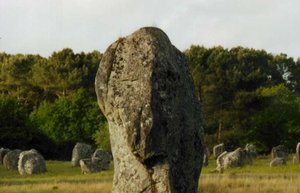Menhir
|
|
A menhir is a large, single upright standing stone (monolith or megalith), of prehistoric European origin.
The word menhir was adopted, via French, by 19th century archaeologists on the basis of words in the Breton language meaning "long stone". In modern Breton the word peulvan is used.
The largest surviving menhir is at Locmariaquer, Brittany, the Grand Menhir Brisé ("Great Broken Menhir") which was once about 20 meters high. It lies broken in four pieces but would have weighed around 330 tons when intact and is thought to be the heaviest object ever moved by humans without powered machinery. In other areas, standing stones were systematically toppled by Christians: of the many former standing menhirs of northern Germany, scarcely one stands today. Alignments of menhirs are also known, the most famous being the megalithic site of Carnac in Brittany (illustration, right), where more than 3000 menhirs are arranged in three groups and arrayed in rows.
The shape of a menhir tends to be square, tapering toward the top. They are generally roughly hewn to shape. Some have vertical grooves and certain of those at Carnac appear to have been partially smoothed.
Practically nothing is known of the cultural context in which the menhirs were erected. We have no trace even of their language. Until recently, they were associated with the Beaker people, who inhabited Europe during the later third millennium BC during the late Neolithic and early Bronze Age. However, more recent research into the age of megaliths in Brittany tentatively suggests a far older origin, six to seven thousand years ago.
In Scandinavia, menhirs continued to be raised during the Pre-Roman Iron Age and later, see Menhir (Iron Age), usually over the ashes of the dead. They were raised both as solitary stones and in formations, such as the stone ships and the stone circles. In the 1st century, the tradition was brought to Northern Poland, probably by the Goths (see the Wielbark Culture).
According to Snorri Sturluson's Heimskringla (see e.g. Vanlade), the menhirs were raised in commemoration of great men. The tradition of raising stones evolved into the runestones [1] (http://www.archaeology.su.se/pdf/caugustsson.pdf), through intermediaries such as the Björketorp Runestone.
Menhirs are favorite objects for speculations of pseudoarchaeology.
Menhirs are familiarly enough associated with prehistoric culture. They are featured prominently in the "Asterix" comics, as familiar items in pop archaeology.
| Contents |
Partial list of menhirs
Spellenstein_03.jpg
England
France
- Carnac, Brittany
- Filitosa, Corsica
- Saint-Sulpice-de-Faleyrens, Gironde (5 m high and 3 m wide, can be found at the nearby port of Pierrefite)
Germany
- Gollenstein, Blieskastel (6.6 m high)
- Spellenstein, St. Ingbert (5 m high)
Portugal
Scandinavia
- Björketorp Runestone, a menhir inscribed with runes.
Wales
See also
- dolmens - megalithic tombs
- standing stone
- megalith
External link
- Megaliths in Europe: (http://www.lessing4.de/megaliths/start.htm) Menhir website
de:Menhir es:Menhir fr:Menhir it:Menhir nl:Menhir pl:Menhir wa:Menir

